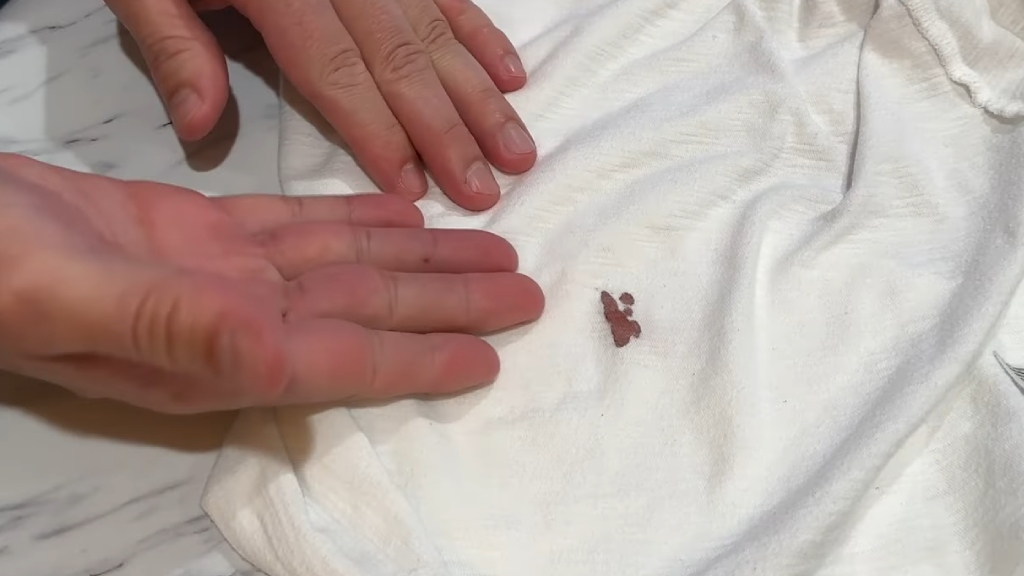How to Get Fish Blood Out of Clothes? Quick Fixes That Work
If you get fish blood on your clothes, act fast by blotting with a clean cloth and rinsing in cold water to prevent setting.
Treat the stain with diluted vinegar or hydrogen peroxide on colorfast fabrics, then soak in cold water with an oxygen-based cleaner for stubborn spots.
Avoid hot water and harsh chemicals, and always test products on a hidden area first. Following these steps greatly improves removal success, discover more ways to salvage your garment effectively.
Key Takeaways
- Blot fish blood stains immediately with a clean cloth and rinse with cold water to prevent setting.
- Soak stained clothes in cold water for several hours, adding enzymatic detergent or oxygen-based cleaner for dried blood.
- Apply undiluted white vinegar or hydrogen peroxide (spot-tested first) on stains to break down proteins and oxidize blood.
- Gently scrub with a soft brush and dish soap after soaking, then wash clothes in cold water with heavy-duty detergent.
- Always wear protective gloves, work promptly, and test stain removal methods on a hidden fabric area to avoid damage.
Immediate Steps to Take When Fish Blood Stains Clothes
When fish blood stains your clothes, act quickly by blotting the area with a clean, white cloth or paper towel to absorb excess blood without rubbing, which can spread the stain and push it deeper into the fabric.
Use cold water to blot or flush the stain, never hot water, as heat sets blood proteins, making removal difficult. Ideally, start treatment within five minutes of the stain appearing.
If possible, flush the fabric from the backside to push blood out rather than further in. Make certain your blotting materials are clean and white to prevent color transfer.
Acting immediately with these steps improves your chances of removing the fish blood stain effectively before moving on to further cleaning methods.
Regular cleaning is essential for fabric longevity, and prompt attention to stains helps prevent long-term damage.
For stubborn stains, using mild detergent and warm water can enhance cleaning effectiveness without damaging the fabric.
Effective Household Products for Removing Fish Blood
You can tackle fish blood stains effectively using household products like OxiClean, hydrogen peroxide, and vinegar combined with detergents.
It is important to avoid using harsh or acidic cleaners that can damage fabric fibers, similar to how pH-balanced cleaners protect granite surfaces.
Hydrogen peroxide works well on fresh or dried stains but test it first to avoid color fading.
Vinegar breaks down blood proteins and neutralizes odors, making it a great pre-treatment before washing.
For particularly stubborn stains, applying hydrogen peroxide directly and allowing it to sit for a few minutes before scrubbing can enhance stain removal.
OxiClean for Stains
Although fish blood stains can be stubborn, OxiClean™ offers a reliable solution for removing them from clothing and washable fabrics.
You’ll want to start by rinsing fresh stains under cold water to improve effectiveness. Cold water prevents setting the stain, making removal easier.
For dried stains, pre-soak the garment in an OxiClean solution for up to six hours. After soaking, wash normally with laundry detergent plus an extra scoop of OxiClean for best results. Using proper soaking techniques helps avoid fabric damage during stain removal.
Here’s how to use OxiClean for fish blood stains:
- Dissolve the recommended scoop in water according to stain severity.
- Apply spray or soak garments, avoiding hot water.
- Blot upholstery stains with an OxiClean solution on a white towel.
- Rinse thoroughly after treatment to remove residue.
OxiClean’s oxygen-based agents lift organic stains safely and effectively.
Hydrogen Peroxide Benefits
Since fish blood stains contain protein-based compounds, hydrogen peroxide proves highly effective at breaking them down.
It foams on contact, oxidizing the iron in hemoglobin and lifting the stain from fabric fibers. You can apply it directly to fresh stains for best results; stubborn or dried stains may require multiple treatments.
To maximize stain removal, it is important to treat stains promptly before they set into the fabric. Proper preparation and inspection of fabric can help determine the safest and most effective cleaning method.
Hydrogen peroxide works well on white and colorfast fabrics but can fade or discolor darker, delicate materials, so test an inconspicuous area first. Using cold water during treatment prevents setting the stain.
Unlike harsher bleach, it’s gentler on fabrics and doesn’t cause yellowing. Plus, it’s inexpensive, widely available, and offers dual action by chemically breaking down blood and gently bleaching.
Always rinse thoroughly afterward to avoid fabric damage and residue buildup.
Vinegar and Detergents
Hydrogen peroxide breaks down protein-based fish blood stains effectively, but household staples like vinegar and detergents offer additional, complementary cleaning power.
Vinegar’s mild acetic acid loosens dried blood and brightens fabric by altering pH. Additionally, vinegar’s acetic acid has mild anticoagulant properties that aid in breaking down blood components.
Detergents, especially enzymatic ones, emulsify and break down blood proteins and fats. Combining them enhances removal: vinegar dissolves dried blood, and detergent lifts oily residues.
Using cold water helps prevent the stain from setting, as hot water can cause proteins to bond more firmly to fabric fibers.
To use vinegar and detergents effectively:
- Blot excess blood with cold water first.
- Soak the stain briefly (about 5 minutes) in vinegar, then rinse thoroughly.
- Pre-soak in cold water with detergent to penetrate and soften the stain.
- Wash normally and air dry to prevent setting.
Test on a hidden area first and avoid hot water, which sets stains permanently.
How to Treat Fresh Versus Dried Fish Blood Stains?
When you catch a fresh fish blood stain, act quickly by rinsing it with cold water and applying natural agents like vinegar to prevent setting.
For dried stains, soak the fabric in detergent and gently scrub with a soft brush, using enzymatic cleaners if needed. Additionally, soaking shirts in an OxiClean solution with warm water for several hours can effectively loosen and remove even old bloodstains.
To avoid damage to your fabrics, it is important to read product labels on cleaning agents before application.
Fresh Stain Immediate Care
If you catch a fish and notice blood on your clothes, act quickly to prevent the stain from setting. Rinse the area immediately with cold water to dilute and flush out the blood—never use warm or hot water, as it sets the stain.
Using hydrogen peroxide reacts with proteins, causing bubbling and breakdown of blood stains on fabrics. For fresh stains, apply hydrogen peroxide carefully after a spot test, blotting gently with cotton balls.
Avoid rubbing to prevent spreading. You can also soak the garment in an oxygen-based cleaner solution to loosen residue before washing in cold water.
Dried Stain Removal Techniques
Although fresh fish blood stains respond well to immediate cold-water rinsing and gentle blotting, dried stains demand a different approach due to protein coagulation and oxidation.
Start by soaking the garment in cold water for several hours to loosen dried residues. Add enzymatic detergents or protein stain removers to the soak to effectively break down the proteins.
Using effective cleaners helps simplify stain removal, especially for stubborn protein-based stains like fish blood. It is important to test cleaners on a small area first to avoid fabric damage.
For white or colorfast fabrics, a hydrogen peroxide soak can oxidize and lighten stubborn stains. Avoid hot water initially, as it sets protein stains further.
After soaking, gently scrub with a soft brush using liquid dish soap or a product like Simple Green to remove oils and slime.
Follow with a cold-water machine wash using heavy-duty detergent. Always check stains before drying to prevent permanent setting.
Repeated Treatment Necessity
Removing fish blood stains often requires repeated treatments, especially when dealing with fresh versus dried stains.
Fresh stains respond better to immediate cold water rinsing and gentle blotting with hydrogen peroxide, but even then, one cycle mightn’t fully lift the blood. Since improper treatment can cause surface deterioration, care must be taken to use appropriate methods.
Dried stains tend to need more aggressive or multiple treatments due to protein bonding with fibers. To effectively remove fish blood stains, keep these steps in mind:
- Soak the fabric in cold water with oxygen-based stain remover like OxiClean for several hours.
- Alternate treatments between hydrogen peroxide and oxygen-based solutions for persistent stains. Early intervention increases stain removal success, so treat stains as soon as possible to prevent them from setting in prompt stain removal.
- Blot gently during early stages to prevent spreading.
- Repeat soaking and washing cycles as needed, maintaining cold water use to avoid setting stains.
Best Soaking Techniques to Loosen Stubborn Blood Stains
When tackling stubborn fish blood stains, soaking your garment properly can make all the difference. Start by soaking in cold water for several hours to loosen dried blood without setting the stain.
For deeper cleaning, prepare a solution with oxygen-based cleaners like OxiClean in warm water and soak the fabric for a few hours; these break down blood proteins effectively and are color-safe.
For fresh stains, a 10-15 minute soak in undiluted white vinegar helps break down blood components; test fabric first. Ammonia can also help when applied carefully via a damp cloth, rinsing continuously until the stain fades.
For older stains, apply hydrogen peroxide directly to bubble and oxidize the blood, but only on white or colorfast fabrics. Hydrogen peroxide suggested as a hospital-grade stain remover is especially effective on tough, set-in stains.
Follow soaking with gentle scrubbing and thorough washing for best results. It’s important to ensure proper ventilation when using strong cleaners to avoid potential overheating risks.
Protective Measures to Prevent Fish Blood on Clothing
Soaking and treating stains helps, but preventing fish blood from reaching your clothes in the first place saves time and effort.
You can substantially reduce exposure by choosing the right clothing and gear, plus adopting careful handling and workstation habits. Using fabrics that reduce particle adherence can further minimize stain buildup.
- Wear dark, synthetic, quick-dry fabrics and use waterproof aprons or smocks as barriers. Acting immediately when blood contacts fabric can improve stain removal success, so having protective layers reduces the need for urgent treatment.
- Protect your skin and sleeves with gloves, arm sleeves, and waterproof jackets to minimize contamination and exposure to pathogens.
- Set up designated cleaning areas with cutting boards and keep cloths and water handy for immediate blotting. It is important to use cold water when blotting fresh stains to prevent the blood from setting into the fabric.
- Handle fish carefully using sharp knives and position blood flow away from your body to minimize splashes, as proper airflow and positioning reduce airborne contaminants.
Safe Practices for Using Stain Removal Chemicals
Although stain removal chemicals can be highly effective, you must handle them with care to protect your health and clothing.
Always read product labels thoroughly, noting instructions, hazards, and fabric restrictions. Use protective gloves and eyewear as recommended.
Apply only the minimum amount needed, avoiding saturation and mixing chemicals, which can cause toxic reactions.
Work in well-ventilated areas—open windows or use fans—to disperse fumes and reduce inhalation risks.
If you experience dizziness or headaches, stop immediately and seek fresh air. Always test stain removers on an inconspicuous area of the fabric first to prevent damage.
Cap bottles tightly after use to prevent spills. In case of skin contact, rinse with cold water promptly and remove contaminated clothing carefully. Seek medical advice if severe reactions occur.
Tips for Maintaining Clothes After Removing Fish Blood Stains
To keep your clothes in good condition after removing fish blood stains, start by rinsing them promptly with cold water to prevent the stain from setting. Then, focus on thorough cleaning and fabric care to preserve your garments.
- Rinse clothes thoroughly to remove all cleaning agents that might damage fibers or irritate skin.
- Use gentle laundry cycles and mild detergents to maintain fabric texture and color.
- Apply fabric softeners after stain removal treatments to restore softness, especially if oxidizers or salt were used.
- Store clothes in dry, ventilated places and use odor-neutralizing sprays or sunlight to prevent lingering fish blood smells and mildew. When dealing with dried blood stains, consider using hydrogen peroxide treatment carefully, as it is effective but may damage some fabrics.
Frequently Asked Questions
Can Fish Blood Stains Cause Fabric Odors if Not Washed Promptly?
Yes, fish blood stains can cause fabric odors if you don’t wash them promptly. The proteins and compounds in fish blood break down and bond with fabric fibers, creating persistent fishy smells.
Delaying treatment lets these odor-causing substances penetrate deeper, making the smell harder to remove. Plus, moisture trapped in the fabric can promote mold growth, worsening the odor.
Are There Natural or Homemade Remedies for Fish Blood Stains?
Picture fresh fish blood on fabric—stubborn yet treatable. You can tackle it naturally by soaking the stain in cold water immediately, then applying white vinegar to break down proteins.
Alternatively, use a salt paste to gently scrub the area, pulling out the stain without harsh chemicals. Baking soda mixed with water also works wonders on set-in stains.
While hydrogen peroxide suits white fabrics, it requires caution to avoid damage. These homemade remedies save your clothes and the environment.
How Does Fish Blood Differ From Other Blood in Stain Removal?
You’ll find fish blood stains tougher to remove than mammalian blood due to nucleated red cells and higher plasma protein content. These factors make fish blood stickier and more resilient on fabrics.
Standard blood stain treatments may not work well, so you’ll need enzyme-based detergents and possibly oxidizing agents like hydrogen peroxide.
Acting quickly with cold water rinses helps prevent the proteins from setting, improving your chances of complete stain removal.
What Fabrics Are Most Resistant to Fish Blood Stains?
Think of fish blood as a stubborn tide trying to seep into your clothes. You’ll want fabrics engineered to repel that wave—synthetics like polyester and nylon stand strong, thanks to their low absorbency.
Fabrics treated with technologies like BloodGuard®, PRO Performance, or HeiQ create a protective shield, keeping stains at bay.
Tight weaves and hydrophobic coatings act like armor, giving you durable, stain-resistant gear perfect for fishing adventures.
Can Fish Blood Stains Be Removed After Multiple Washings?
Yes, you can remove fish blood stains after multiple washings, but it takes more effort. Since proteins bind deeply, you’ll need oxygen-based cleaners or hydrogen peroxide for soaking.
Pre-soak the garment for several hours, apply stain removers, and avoid heat drying, which sets stains.
Repeated treatments—soaking, scrubbing, washing—improve results. Remember, some fabrics may discolor or weaken, so test treatments first and accept some stains might be permanent.
Say Goodbye to Fish Blood Stains for Good
When fish blood stains your clothes, act swiftly—don’t let the crimson set like a stubborn shadow. Use household heroes like cold water and gentle detergents to break the stain’s grip.
Remember, fresh stains are whispers; dried ones roar, so soak wisely and treat with care. Protect your fabrics like armor, and handle chemicals safely.
With these steps, you’ll keep your clothes spotless, turning potential messes into nothing more than a ripple in your day.







